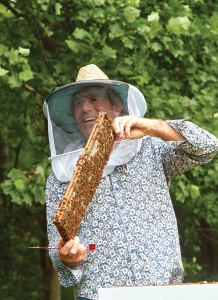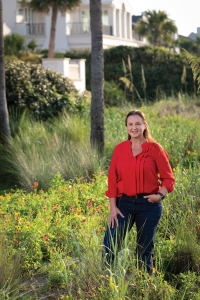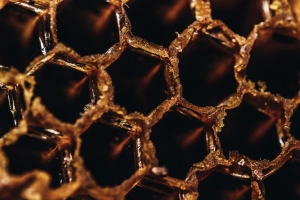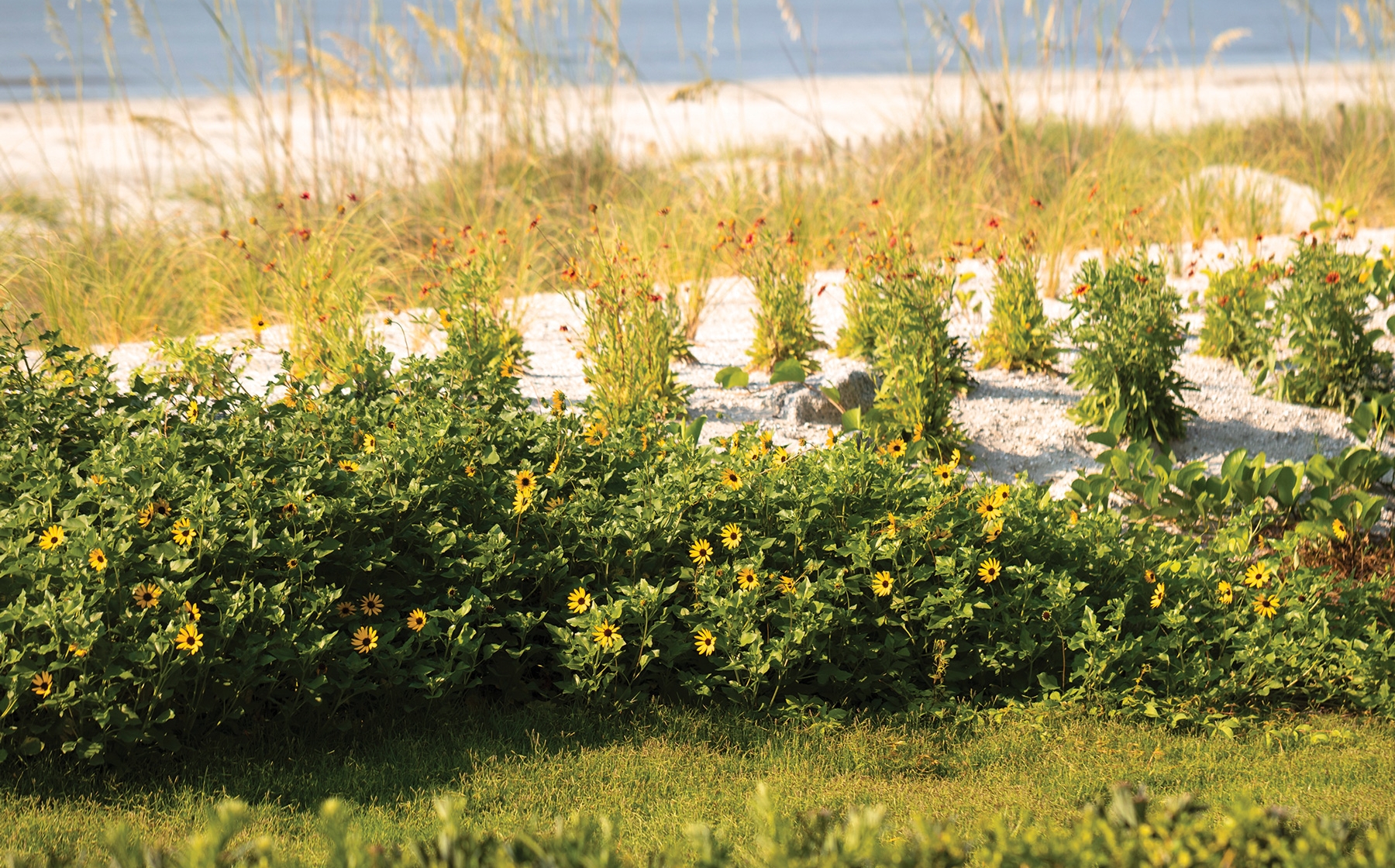The Beautiful Bee
From honey to harvest, bees are little creatures with a big impact.
Tupelo. Wildflower. Acacia. Orange blossom. The litany of honey varieties continues almost endlessly, each one offering a unique flavor profile or home remedy solution. Eucalyptus honey with its herbaceous, medicinal quality is well-suited for tea. Thick, molasses-esque buckwheat honey coats meats, and its impressive antioxidants are said to calm a sore throat. Some even say a spoonful of local honey keeps seasonal allergies at bay. Regardless of taste or tincture, honey is a highly beneficial natural resource. All thanks to the endless efforts of honeybees.
BUZZWORTHY HISTORY
Honeybees have fascinated humans for thousands of years. According to Smithsonian Magazine, the earliest evidence of beeswax dates to 7,000 B.C. in Anatolia. Those records show beeswax residue on ancient pottery, leading archeologists to believe the discovered vessels could have been used for extracting or even storing honey. Egyptians are credited with the first domesticated hives, and they held bees in high regard. In 3,500 BC, the bee was the symbol of the Lower Egyptian King. From then on, bees remained closely associated with royalty, representing powerful rulers such as Napoleon.
Upon the death of Queen Elizabeth in 2022, her royal bees were informed of her passing. John Chapple, the palace beekeeper, ceremoniously tied black ribbons into bows onto each hive.
Even celebrities such as Martha Stewart and Beyoncé have their own hives. Morgan Freeman owns a more than 100-acre Mississippi farm notably cared for as a bee sanctuary, and Scarlett Johansson reportedly received a honey hive from Samuel L. Jackson as a wedding gift. While it seems as though people have always been enamored by the power of the honeybee, recognizing and protecting the species is more important than ever before.
POWERFUL POLLINATORS
Bees play a vital role in our agricultural system. According to the U.S. Department of Agriculture, honeybees alone “pollinate 80% Ted Dennard’s beekeeking hobby was the start of Savannah Bee Co. of all flowering plants, including more than 130 types of fruits and vegetables.” What is even more astounding is that once those crops are harvested, one out of every three bites of our food is created with the help of pollinators.

While apiary advocates exist across the world and country, one of the largest protectors of the bee population does his work from coastal Georgia. Ted Dennard, who grew up in the St. Simons Island area, is the founder of Savannah Bee Co. Dennard has been a beekeeper for nearly his entire life, falling in love with bees and their sweet nectar at the young age of 14. “That led to my love of honey varieties and sparked a fire that would become my lifetime passion,” he recalls. As a young man, Dennard taught beekeeping for the Peace Corps. Eventually, a few friends convinced him to sell his honey as Christmas gifts, and that is how Savannah Bee Co. was humbly born. Today, the company spans 14 retail locations, has an online product inventory of over 170 items and sells about 27 different types of honey, including hot honey, monofloral honeys and flavored whips.
Dennard says the bees along Georgia’s coast flourish largely due to the area’s weather and natural resources. Forests of holly and palmetto are large nectar sources for bees. Even the storied Okefenokee Swamp, a nearly 400,000-acre National Wildlife Refuge, has long been known for its exceptional bee habitat. According to the archives at Valdosta State University, the counties surrounding the Okefenokee Swamp are home to the state’s largest commercial honey operations thanks to its gallberry shrubs and tupelo gum trees. These are known by locals as “honey plants.” Dennard, a lifelong coastal Georgia resident confirms, “The Okefenokee Swamp produces the most honeycomb of anywhere in the country.”
ATTRACTIVE AGRICULTURE

Landscape Architect Rachael Strickland and her team at Sea Island plant a variety of native shrubs, perennials, and herbs to create a lush environment for pollinators.
Rachael Strickland’s role as a landscape architect at Sea Island goes much deeper than maintaining the beautiful grounds. She’s largely responsible for its colony of pollinators, too. “Bees are the most important pollinators in agriculture and nature, so by planting and cultivating a diverse environment for bees, we enhance the health and well-being of all species, including humans,” she says.
Landscape architecture plays a key role in preserving and supporting native habitats for bees. To aid the island’s pollinators, Strickland and her peers plant a variety of native shrubs, perennials and herbs in a rainbow of enticing colors across the resort. “They’re full of both nectar and pollen,” she notes. Come fall, bees typically stop flying and hibernate around the queen, surviving off of the honey stored during the year. Therefore, choosing the right landscaping is a year-round job, not solely resolved for maintaining an attractive property but for providing a well-fed life for bees, too.
When it comes to growing a bee-friendly garden, consider planting flowers alongside your fall vegetables. The blooms will keep your bees happy.
Strickland recommends the following varieties:
ASTER: These perennial-like daisies can grow up to 6 feet tall and come in shades of white, pink, purple and occasionally blue.
BEE BALM: Also known as bergamot, bee balm is a hardy plant that grows well in the sun, ideal for our warm fall days.
BLACK-EYED SUSAN: These golden and vibrant flowers tend to draw creatures such as butterflies and birds.
CASSIA: Cassia is a part of the legume family and produces cascading yellow flowers.
COREOPSIS: The colorful blooms of coreopsis, also known as tickseed, attract bees and are low maintenance.
VERBENA: Verbena flowers can bloom atop of their own wilted flowers, making it an ideal plant for novice gardeners.
SWEET REWARDS
Honeybees themselves are essentially the same worldwide, but the honey they produce tastes different due to their various nectar sources. Tupelo honey, for example, is made from the nectar of those rare flowering trees found in the slow-moving black water rivers. Sourwood honey comes from the north Georgia mountains. “Those two honeys are arguably the best in the world,” Dennard notes.

Honeycombs are made up of hexagonal beeswax cells that serve as storage units for honey.
How does that nectar turn into honey? Let’s just say bees get their reputation as “workers” honestly. Dennard explains that collectively bees have to visit 2,000,000 flowers to make one pound of honey, and every colony will visit over 500,000,000 flowers each year. Of course, it all centers around the queen who gives her hive purpose. She can live 40 times longer than an average worker bee.
Should you envision yourself as a beekeeper, you’re in luck. “It is easy to begin and is a lifetime of learning from there,” Dennard comments. He recommends joining a local beekeeping club, doing ample research and asking as many questions as you can.
Beyond supporting thousands of beekeepers daily, Savannah Bee Co. is doing its part in inspiring the next generation of beekeepers, too. The Bee Cause Project, a nonprofit co-founded by Dennard, teaches school-aged children everything there is to know about bees and honey production. Through the organization, nearly 1,000 hives are now at schools across the U.S., Canada and the Caribbean.
Even large corporations are enhancing the bee population. For example, the Intercontinental Exchange in Sandy Springs, Georgia, just outside of Atlanta, hosts three honeybee hives on the campus in partnership with Bee Downtown, which places and monitors honeybee hives in major metropolitan areas, and Sterling Culinary Management, which provides culinary management services. The honey produced from the hives at the Intercontinental Exchange is ultimately used for various menu items at Sterling Spoon, the campus café run by Sterling Culinary Management.
“When a corporation installs hives on its campus, it impacts three miles in every direction, which is the distance a honeybee will fly in search of food,” explains John Metz of Sterling Culinary Management. By adding hives in urban areas, urban plants and vegetables flourish, and the greater community is positively impacted as well.
Bee Downtown’s corporate hives are found on campuses in cities such as Atlanta, Charlotte, D.C., Orlando, Raleigh/Durham and Richmond. Companies such as Chick-fil-A, Delta, Pinewood Studios, Georgia Power and AT&T all have Bee Downtown hives. In addition to these grassroots efforts, large commercial beekeepers also play a pivotal role in apiary growth and protection. According to the USDA, commercial beekeepers are responsible for providing the majority of pollination services to growers, making their jobs some of the most important in the agriculture industry and beyond.
“A commercial beekeeper has at least 1,000 hives. Here in Homerville in Clinch County, Georgia, we are responsible for 2,400 hives,” says honeybee farmer Ben Bruce. Thanks to what we know about bees, the agricultural impact from Bruce’s hives stretches well beyond his farms.
Whether watching bees enjoy a bright flower or tasting your favorite honey, take a moment to reflect on the amazing bee. Without these pollinators, our world would look and taste remarkably different.




